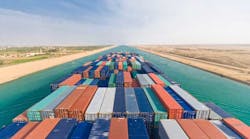Over the past eight weeks, I’ve had the opportunity to visit Panama and Egypt to get a first-hand sense of the dramatic expansions occurring around each of their canals.
In discussions with senior officials in both countries, I’ve come to the conclusion that there is a healthy competition stirring between the two. And, ultimately, we all will benefit.
Presently, Panama and Suez are challenging one another for supremacy of the container shipping market for imports into the U.S. East Coast from the Far East.
In Central America, the long-awaited $5.25 billion expansion of the Panama Canal — the 50-mile waterway that connects the Atlantic and Pacific oceans —is nearing completion. Scheduled for April 2016, a new set of locks will allow some of the biggest ships in the world better access to U.S. ports. Just this past March, Panama announced it was also considering construction of yet another set of locks to handle even larger vessels, those that can handle in excess of 20,000 twenty-foot equivalents (TEUs).
Egypt has launched equally bold plans at Suez. In addition to widening the canal, construction is underway for an industrial and logistics hub. It is the biggest project at Suez since the completion of the canal 150 years ago. The expansion at Suez is an $8 billion investment, which is being directed by the Egyptian army and financed by Egypt’s citizens who have enthusiastically purchased Canal Investment Certificates.
As the expansion at Panama gets closer to being finished, Suez is feeling the heat to retain its superiority in handling the biggest ships in the world. Moreover, Panama recently announced a new customer-loyalty program for the container segment that will see shippers receive "premium prices" once a particular volume is reached.
Going forward, the energy revolution might play an even more significant role in determining how the two canals interact with one another. While no one predicted it a few years ago, the U.S. is now the largest carbon producer in the world.
With the U.S. gearing up to export liquefied natural gas (LNG), both locations will be battling for that traffic from America.
Currently only 23 ships in the global fleet of 421 LNG carriers can pass through the Panama Canal. Once the expanded canal in Panama is operational, it will become the shortest route for moving gas commodities from the Gulf of Mexico to North Asia. For example, the distance from the U.S. Gulf to Japan will be around 9,214 nautical miles, compared with 14,570 nautical miles via the Suez Canal. Assuming a speed of 19.5 knots, the reduced distance can result in savings of around 22 days on a round trip voyage from Panama.
Suez is not sitting still, however. In February, the Egyptians announced an increased discount for LNG carriers, lowering rates for the first time since 1994.
It is clear both locations are doing things that will enhance global trade and supply chain facilitation for decades to come. Long live competition!




